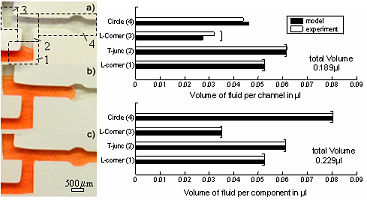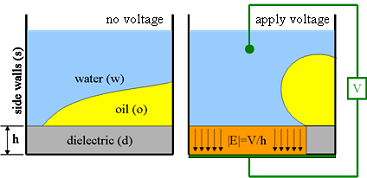Min Energy Methods for Liquid Shape Prediction: Network Filling, Active Optical Pixels, …
Students: Mike Chinn, Neil Fortner, Inna Treise
Collaborators: H.Feil, Phillips; A.Hightower, Nanostream
Fast numerical methods to find equilibrium shapes of liquids in arbitrary geometries under applied fields. Methods necessary for predicting flows in fluidic networks, electrowetting systems, active optical pixels, …
Below: Filling of a small network: theory vs experiment. Network is shown on
left. Right graph shows filling model vs experiment at two different times. The model
can predict filling of a network with 10,000 components in seconds.

 Modeling active pixels. Right: Color change
due to oil shape actuation (figure courtesy Phillips). Below: Basic physics –
minimize surface tension vs dielectric energy. Bottom: Oil shapes versus voltage (using
Surface Evolver software by K.Brakke, Susquehanna Univ)
Modeling active pixels. Right: Color change
due to oil shape actuation (figure courtesy Phillips). Below: Basic physics –
minimize surface tension vs dielectric energy. Bottom: Oil shapes versus voltage (using
Surface Evolver software by K.Brakke, Susquehanna Univ)


